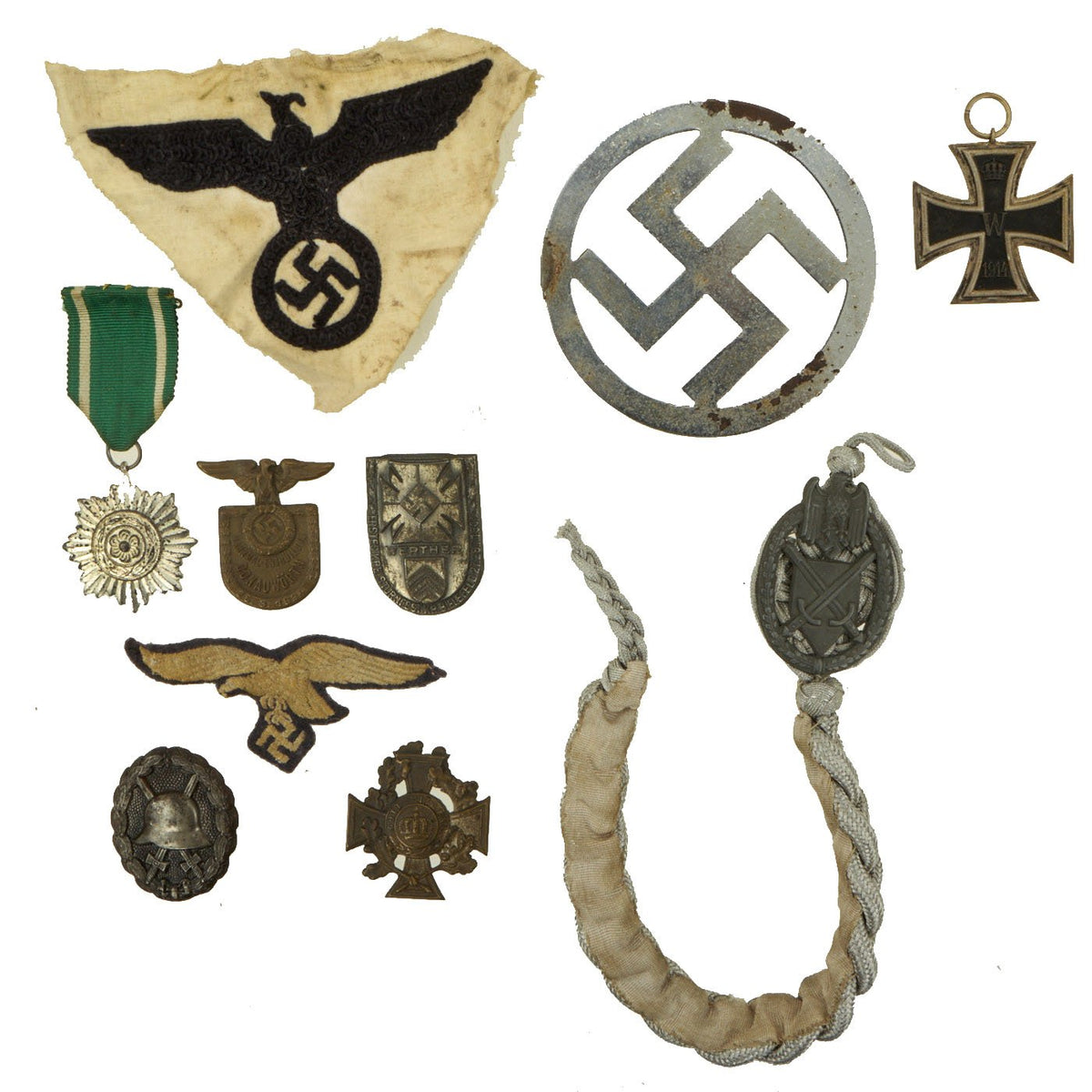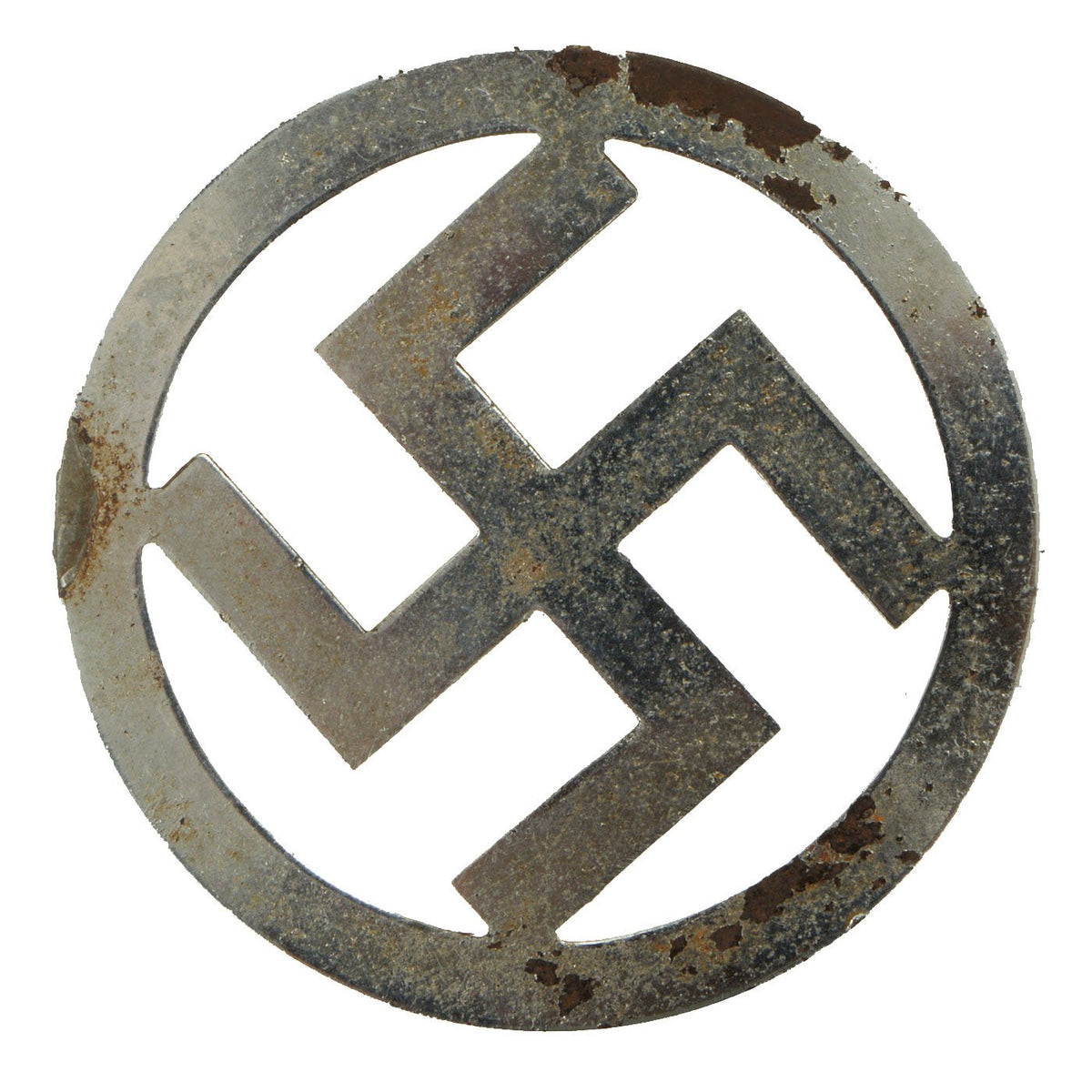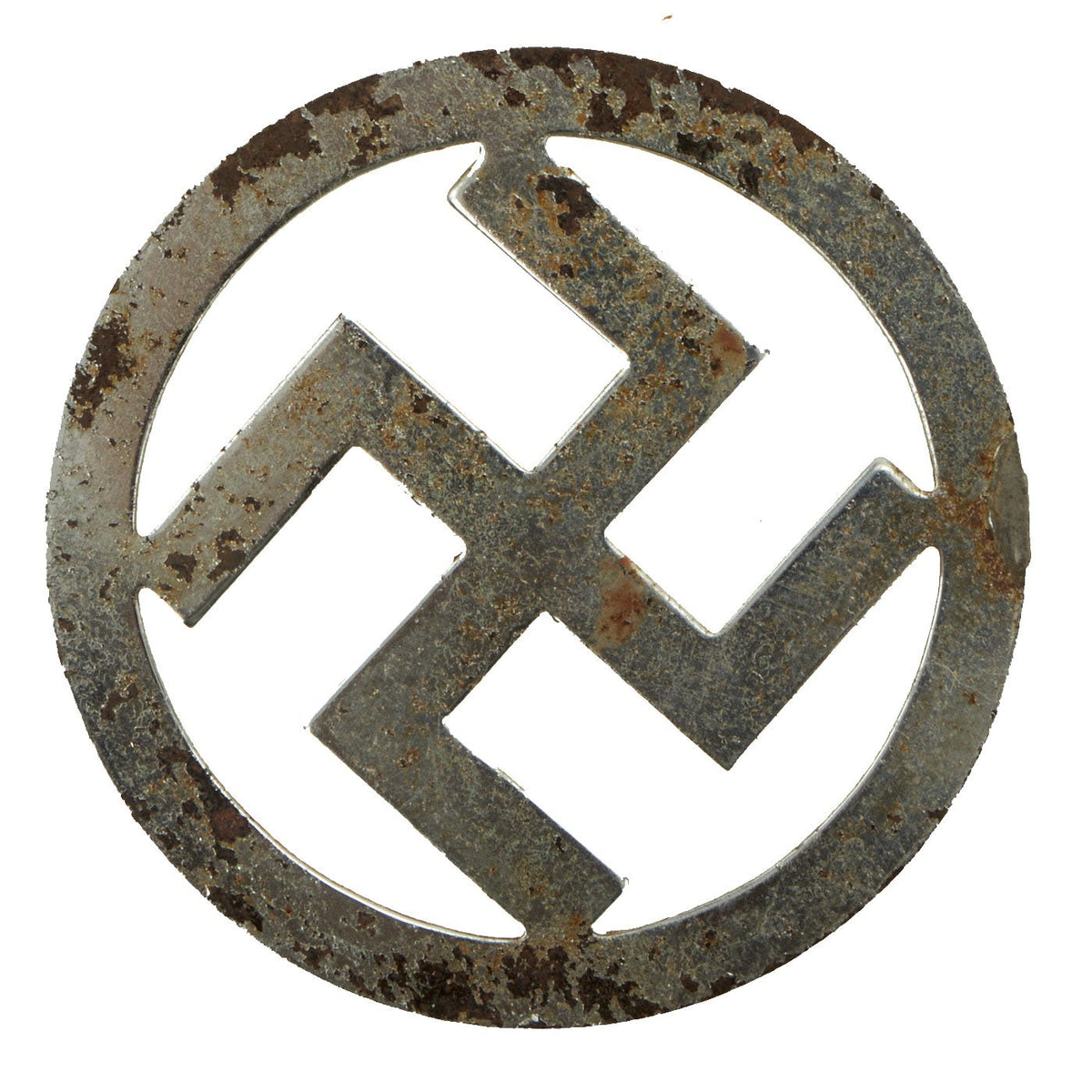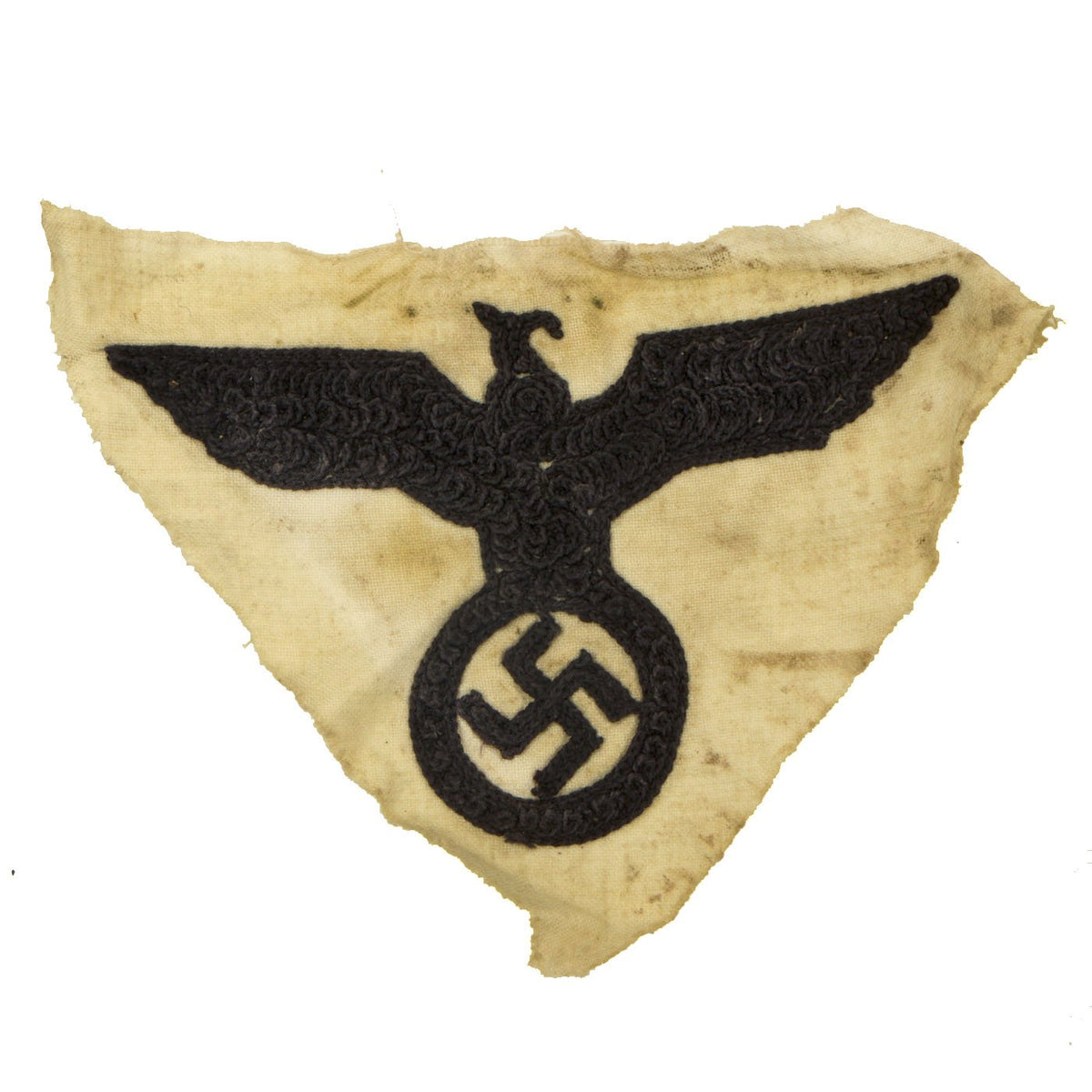Original German WWI & WWII Medal and Insignia Grouping with 1914 EKII & Eastern People’s Medal – 10 Items Original Items
$ 395,00 $ 118,50
Original Items: Only One Set Available. This is a very nice collection of German WWI & WWII Insignia & Awards, which was brought back from the European theater by a USGI after the war was concluded. It includes some a wide variety of medals and insignia, including an Imperial German Iron Cross, a marksmanship lanyard, and more!
This lovely set includes:
– One Imperial German WWI Iron Cross 1914 2nd Class Medal (Eisernes Kreuz 2. Klasse, or EKII). In really good cosmetic shape with a maker mark of M on the hanger ring. The Ribbon is unfortunately missing.
– One Imperial German WWI Hollow Back 3rd Class Wound Badge in Black. It is in very good condition, and is made from stamped steel.
– One German WWII 2nd Pattern Grade I Heer Army Marksmanship Lanyard without acorns.
– One German WWII Eastern People’s Medal 2nd Class (Ostvolkmedaille II. Klasse) in silver, with the correct green ribbon with white stripes. This is the version without swords, for merit in areas other than combat.
– One German WWII Luftwaffe Breast Eagle Embroidered Badge.
– One German WWII NSDAP Plated Steel Swas Insignia from the top of a flag pole topper, 3 1/2″ diameter.
– One German WWII Embroidered NSDAP Reichsadler (National Eagle) insignia cut out.
– One German Pre-WWII Gymnastics Event Tinnie from Bielefeld dated 1935.
– One German Pre-WWII Donauwörth Event Tinnie dated 1934
– One Imperial German WWII Iron cross Tinnie Pin.
A wonderful totally genuine grouping perfect for the German Medal and Insignia collector.
German WWI Prussian Iron Cross 2nd Class with Ribbon:
Established by Frederick William in 1813 for gallantry in action, the Eisernes Kreuz (EK) decoration was revived several times for later conflicts. The bulk of the issues are divided into 1st and 2nd class versions, but a rare and superior ‘Grand Cross’ was also awarded for successful field commanders. During WW1 the lower decoration was freely awarded with 5½ million second class types issued. Originally, the Iron Cross was an award of the Kingdom of Prussia, however given Prussia’s pre-eminent place in the German Empire formed in 1871, it became an award for all of Germany.
The basic design of the WW1 crosses is a central cross patee struck from iron and mounted in a silver frame which has a raised crenulated decorative border. The obverse of the cross bears the date 1914 under a crowned ‘W’ monogram. Reverse bears an oak leaf cluster with the date of the decoration’s institution, 1813 underneath – the crowned initials of Frederick William are in the top arm above the oak leaf cluster. Suspension for second-class types is by means of a ring, and frequently this ring bears a maker’s stamp.
Please examine the edge seam for authentication, which is not present on reproductions. Iron crosses were commonly constructed from an iron core sandwiched in a surrounding two part silver frame, normally the seam of these two silver parts is visible around the edge of the cross as is seen on this fine example.
The German Wound Badge (Verwundetenabzeichen) was instituted by Kaiser Wilhelm II on 3 March 1918 during the First World War to recognize those wounded in the conflict. It was designed using a World War One style Imperial German Stahlhelm helmet as the main motif. The helmet was set on top two crossed swords against a pebbled background and surrounded by a laurel leaves wreath.
The Wound Badge Awards came in three different types of grades representing the amount , or severity, of wounds received. The first grade, the Black Wound Badge was awarded for 1 to 2 wounds received in combat. The Silver Grade was awarded for 3 to 4 wounds, and finally the Gold Grade for 5 or more wounds, total disability, or death.
German WWII Eastern People’s Medal:
Officially termed the “Medal for Gallantry and Merit for Members of the Eastern Peoples” (Tapferkeits und Verdienstauszeichnung für Ostvölker). This was a military and paramilitary award of Germany. Established on 14 July 1942, it was bestowed on personnel from the former Soviet Union (Ostvolk or “Eastern people”), who volunteered to fight alongside German forces. The Medal is sometimes called the Ostvolk Medal or Eastern People’s Medal, (Ostvolkmedaille).
The Ostvolk medal features an octagonal (eight pointed) star with a plant pattern in the center. There were two classes:
1st class – 50 mm in diameter, attached to the left uniform pocket by a pin and clasp. It could be awarded in gold or silver.
2nd class – 40 mm in diameter worn on a 32 mm wide ribbon from the left chest. It could be awarded in gold, silver or bronze, each having a separate ribbon design:
– gold: green with a red stripe towards each edge;
– silver: green with a white stripe towards each edge;
– bronze: plain green.
Fast Shipping with Professional Packaging
Thanks to our longstanding association with UPS FedEx DHL, and other major international carriers, we are able to provide a range of shipping options. Our warehouse staff is expertly trained and will wrap your products according to our exact and precise specifications. Prior to shipping, your goods will be thoroughly examined and securely secured. We ship to thousands clients each day across multiple countries. This shows how we're dedicated to be the largest retailer on the internet. Warehouses and distribution centres can be located throughout Europe as well as the USA.
Note: Orders with more than one item will be assigned a processing date depending on the item.
Before shipping before shipping, we'll conduct a thorough inspection of the items you have ordered. Today, the majority of orders will be delivered within 48 hours. The delivery time will be between 3-7 days.
Returns
The stock is dynamic and we cannot completely manage it because multiple stakeholders are involved, including our factory and warehouse. So the actual stock may alter at any time. It's possible that you may not receive your order once the order has been made.
Our policy is valid for a period of 30 days. If you don't receive the product within 30 days, we are not able to issue a refund or an exchange.
You can only return an item if it is unused and in the same state as the day you received it. You must have the item in its original packaging.
Related products
Uncategorized
Uncategorized
Uncategorized
Uncategorized
Uncategorized
Uncategorized
Uncategorized
Armoured Fighting Vehicles of the World: AFVs of World War One (Hardcover Book) New Made Items
Uncategorized
Band of Brothers ORIGINAL GERMAN WWII Le. F.H. 18 10.5cm ARTILLERY PIECE Original Items
Uncategorized
Uncategorized
Uncategorized
Uncategorized
Uncategorized
Uncategorized
Uncategorized
Uncategorized
Uncategorized












































































